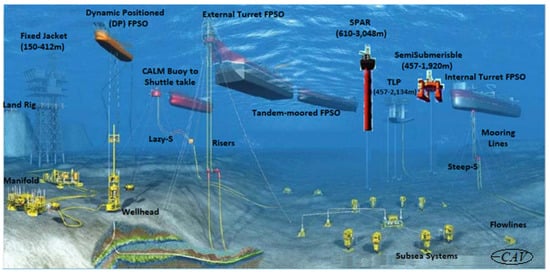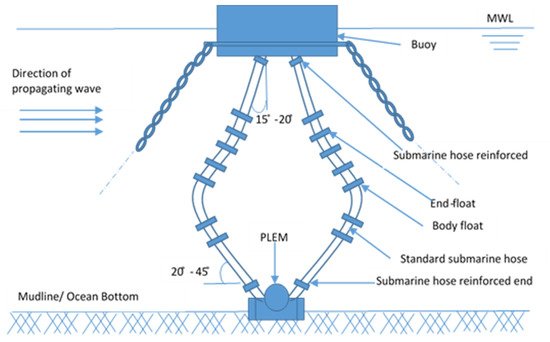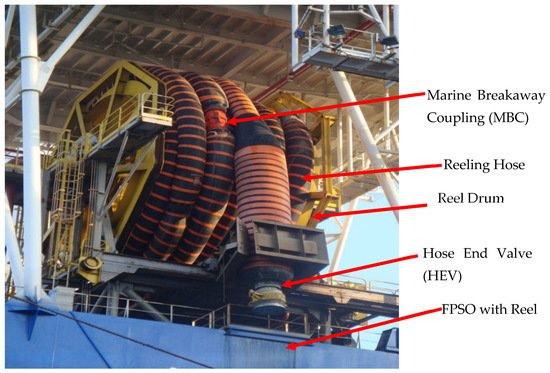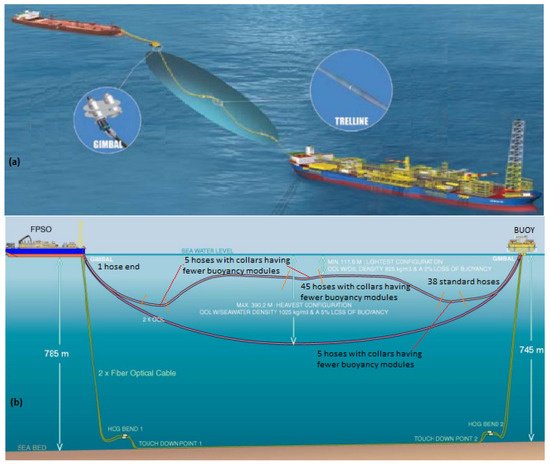By characterisation, a marine hose is a unique type of flexible riser used in fluid transfer. By definition, a marine hose is simply a fluid transfer conduit utilised in transferring, discharging, loading, and transporting fluids from an oil well to the platform of a floating platform or a floating structure. The fluid transfer system for bonded marine hoses is dependent on floating offshore structures (FOS). Single Point Mooring (SPM) systems are component aspects of the techno-economic design and FOS operation.
- bonded marine hose
- sustainable fluid transfer
- single point mooring (SPM)
- Catenary Anchor Leg Mooring (CALM)
- buoy
- Floating Offshore Structures (FOS)
- offshore platform
1. Introduction


2. Sustainable Fluid Transfer at SPM Mooring Terminals
2.1. Sustainable Fluid Transfer Operation

-
The PLEM and the buoy are connected by flexible subsea hoses known as risers. The arrangement can take the form of a Chinese lantern, Lazy-S, Lazy Wave, or Steep-S depending on depth, sea state, buoy motions, and other factors.
-
The buoy is connected to the tanker by floating hose strings.
-
Marine breakaway coupling that enables for emergency pipeline disconnection to prevent hose/hawser breakage and associated oil spills.
-
The tanker can rotate with relation to the mooring buoy thanks to the product swivel, valves, and piping that connect the geostatic and rotating components of the buoy.
2.2. Preparation & Arrangement of SPM Moorings
On Single Buoy Mooring (SBM), the hawser is normally made up of nylon rope shackled to an integrated mooring uni-joint on the buoy deck. A chafing chain is attached to the tanker end of the hawser to prevent damage from the tanker fairlead. To measure hawser loads, a load pin can be attached to the mooring uni-joint on the buoy deck. Depending on the biggest size of vessel that would be anchored to the buoy, hawser systems use one or two ropes, as depicted in Figure 2 and Figure 74. Single-leg or grommet-leg ropes could be the type of ropes used. On the tanker side, these are frequently attached to an Oil Companies International Marine Forum (OCIMF) chafing chain. This can be either type A or B, depending on the maximum size of the tanker and the mooring loads. This chafe chain would then be secured in the tanker’s chain stopper.
-
For picking up rope, a messenger line has been requested.
-
It must be fitted in an empty drum at the bow, large enough to hold a 120 m [or longer, depending on terminal advice] Pick Up Rope.
-
The messenger must be 100 metres long (or as instructed by the terminal).
-
The messenger should be 1”−3” wide, and at its end have one small shackle.
-
The afterdeck specification to be used on the Tug Boat should be 02 × 200 Mt.
3. Model Application of Bonded Marine Hoses
Bonded marine hoses are for loading and offloading purposes. These hoses are used in a wide range of mooring systems. The circumstances under which they must operate also differ based on environmental conditions, size of the oil well, the water depth, the capacity of the terminal, the amount of hoses, the sizes of the hoses, the number of mooring chains (or mooring lines), the number of shuttle vessels, the schedule of daily operation, and the designed (un)loading system. Even within a single system, there are differences in the specifications of the many segments that make it up.
3.1. Configurations for Submarine Hoses
3.1.1. CALM Buoy Hose Configurations
The Catenary Anchor Leg Mooring (CALM) buoy system comprises a buoy with pivot, called the turntable. Sometimes, it is called the turret buoy or turntable buoy. Figure 7 4 shows the different configurations of Catenary Anchor Leg Mooring (CALM) buoy systems. The CALM buoy system has different connections, such as the mooring fairlead and hose manifold. The tanker is anchored to the turntable pivot, as it rotates around its vertical axis. The turntable is also connected to the floating hose through the hose manifold at an angle. The tanker is attached to the turntable and connected to the turntable’s floating hose strings. The mooring chains or anchor chains are used to moor the buoy as it aids in the buoy’s stability. A swivel transfers the fluid to the submarine hose strings connected to the undersea pipeline via the pipeline end manifold. The entire system can freely spin due to the forces applied by currents and waves, a phenomenon known as weathervaning. Figure 8 5 depicts an internal turret FPSO with multiple arrangements of marine hoses and flexible risers on an FPSO.
3.1.2. Chinese-Lantern Hose Configurations

3.1.3. Lazy-S Hose Configurations

3.1.4. Steep-S Hose Configurations

3.2. Configurations for Floating Hoses
3.2.1. SALM Buoy Hose Configurations

3.2.2. Floating Tandem Mooring Hose Configurations

| No. | Location | Description | Hose Type | Optional Type | Characteristics | Application |
|---|---|---|---|---|---|---|
| 1 | FPSO Connection | Off take connection | Floating | Reel | Reinforced hose end, at one end | Connected to shuttle tanker bow loading point or FPSO |
| 2 | Reduced Buoyancy | Reducer | Floating | Reel | Reduced buoyancy or Neutral | Often next to 2–3 hose sections on the string |
| 3 | Mainline | Mainline | Floating | Reel | Fairly flexible | Main part of the floating hose string |
| 4 | Operational Taper | Taper | Floating | Reel | Integral reducing bore | Connection of smaller bore tail hose and larger bore mainline |
| 5 | Tail | Tail Hose | Floating | Reel | Electrically discontinuous | Smaller bore diameter compared to mainline. Links tanker end to handle rail hose |
| 6 | Rail | Rail Hose | Floating Rail | Reel | Higher flexibility during lug lifting | Over rail hose for connecting to the manifolds of conventional midships |
3.2.3. Stored Hose (or Hose Reel) Tandem Mooring


3.2.4. Deepwater Export Lines

Abbreviations
| CALM | Catenary Anchor Leg Mooring |
| FPSO | Floating Production Storage and Offloading |
| FSO | Floating Storage and Offloading |
| FSRU | Floating Storage and Regasification Unit |
| FSU | Floating Storage Unit |
| HEV | Hose End Valves |
| MBC | Marine Breakaway Coupling |
| MBM | Multi Buoy Mooring (or Multiple Buoy Mooring) |
| OCIMF | Oil Companies International Marine Forum |
| PLEM | Pipeline End Manifold |
| SALM | Single Anchor Leg Mooring |
| SBM | Single Buoy Mooring |
| SDG | Sustainable Development Goals |
| SPAR | Single Point Anchor Reservoir |
| SPM | Single Point Mooring |
| TLP | Tension Leg Platform |
| UN | United Nation |
References
- Charlesworth, D.; D’All, B.; Zimmerlin, C.; Remita, E.; Langhelle, N.; Wang, T. Operational experience of the fatigue performance of a flexible riser with a flooded annulus. In Proceedings of the Offshore Technology Conference (OTC), Rio de Janeiro, Brazil, 4–6 October 2011. Paper Presented at the OTC: Brasil.
- Dahl, C.S.; Andersen, B.A.M.; Gronne, M. Developments in managing flexible risers and pipelines, a suppliers perspective. In Proceedings of the Offshore Technology Conference, Houston, TX, USA, 2–5 May 2011.
- Obrien, P.; Meldrum, E.; Overton, C.; Picksley, J.; Anderson, K.; MacLeod, I. Outcomes from the SureFlex joint industry project—An international initiative on flexible pipe integrity assurance. In Proceedings of the Offshore Technology Conference, Houston, TX, USA, 2–5 May 2011.
- Amaechi, C.V. Numerical investigation on mooring line configurations of a Paired Column Semisubmersible for its global performance in deep water condition. Ocean Eng. 2021, in press.
- Amaechi, C.V. Dynamic analysis of tensioner model applied on global response with marine riser recoil and disconnect. Ocean Eng. 2021, in press.
- Amaechi, C.V. Parametric investigation on tensioner stroke analysis, recoil analysis and disconnect for the marine drilling riser of a Paired Column Semisubmersible under deep water waves. Ocean Eng. 2021, in press.
- Amaechi, C.V.; Chesterton, C.; Butler, H.O.; Wang, F.; Ye, J. Review on the design and mechanics of bonded marine hoses for Catenary Anchor Leg Mooring (CALM) buoys. Ocean. Eng. 2021, 242, 110062.
- Amaechi, C.V.; Wang, F.; Ye, J. Mathematical modelling of marine bonded hoses for single point mooring (SPM) systems, with catenary anchor leg mooring (CALM) buoy application—A review. J. Mar. Sci. Eng. 2021, 9, 1179.
- Amaechi, C.V.; Wang, F.; Ye, J. Numerical assessment on the dynamic behaviour of submarine hoses attached to CALM buoy configured as lazy-S under water waves. J. Mar. Sci. Eng. 2021, 9, 1130.
- Amaechi, C.V. Numerical studies on CALM buoy motion responses and the effect of buoy geometry cum skirt dimensions with its hydrodynamic waves-current interactions. Ocean Eng. 2021, in press.
- Amaechi, C.V. Investigation on hydrodynamic characteristics, wave-current interaction, and sensitivity analysis of submarine hoses attached to a CALM buoy. J. Mar. Sci. Eng. 2021, 9. in press.
- Rutkowski, G. A Comparison between conventional buoy mooring CBM, single point mooring SPM and single anchor loading SAL systems considering the hydro-meteorological condition limits for safe ship’s operation offshore. TransNav Int. J. Mar. Navig. Saf. Sea Transp. 2019, 13, 187–195.
- Amaechi, C.V. Novel Design, Hydrodynamics and Mechanics of Marine Hoses for Oil/Gas Applications. Ph.D. Thesis, Lancaster University, Lancaster, UK, 2021.
- Amaechi, C.V.; Wang, F.; Hou, X.; Ye, J. Strength of submarine hoses in Chinese-lantern configuration from hydrodynamic loads on CALM buoy. Ocean Eng. 2019, 171, 429–442.
- Amaechi, C.V.; Ye, J.; Hou, X.; Wang, F.-C. Sensitivity studies on offshore submarine hoses on CALM buoy with comparisons for Chinese-lantern and lazy-S configuration OMAE2019-96755. In Proceedings of the 38th International Conference on Ocean, Offshore and Arctic Engineering, Glasgow, UK, 9–14 June 2019.
- Trelleborg. Surface Buoyancy Brochure; Report BC-SUR-v1.3-EN; Trelleborg: Trelleborg, Sweden, 2017; pp. 1–24. Available online: https://www.trelleborg.com/en/marine-and-infrastructure/products-solutions-and-services/marine/surface-buoyancy (accessed on 25 October 2021).
- Trelleborg. Oil & Gas Solutions: Oil & Gas Hoses for Enhanced Fluid Transfer Solutions; Trelleborg: Clemont-Ferrand, France, 2016.
- Rampi, L.; Lavagna, P.; Mayau, D. TRELLINE? A cost-effective alternative for oil offloading lines (OOLs). In Proceedings of the Offshore Technology Conference, Houston, TX, USA, 1–4 May 2006.
- Prischi, N.; Mazuet, F.; Frichou, A.; Lagarrigue, V. SS-offshore offloading systems and operations bonded flexible oil offloading lines, a cost effective alternative to traditional oil offloading lines. In Proceedings of the Offshore Technology Conference, Houston, TX, USA, 30 April–3 May 2012.
- Mayau, D.; Rampi, L. Trelline—A new flexible deepwater offloading line (OLL). In Proceedings of the Sixteenth International Offshore and Polar Engineering Conference, San Francisco, CA, USA, 28 May–2 June 2006; Available online: https://onepetro.org/ISOPEIOPEC/proceedings-abstract/ISOPE06/All-ISOPE06/ISOPE-I-06-127/9875 (accessed on 12 October 2021).
